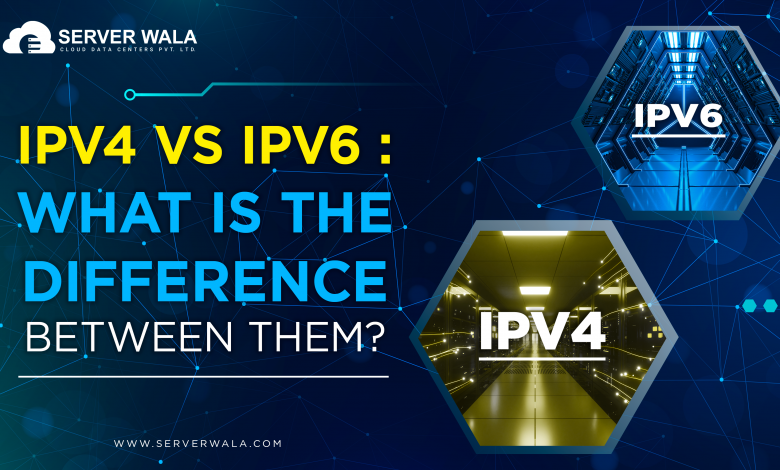IPv4 vs IPv6: What is the Difference between IPv4 and IPv6?

As IoT (Internet of Things) continues to expand exponentially, new devices are being connected online every day. It is feared that addresses will run out at some point. This conjecture is becoming more accurate.
There is no need to fear the end of the Internet. IPv4 addresses are diminishing, but there is a solution. As the Internet of Things continues to grow, it will be necessary to address key issues including creating IPv6 addresses and keeping up with the growth of IoT devices.
We will also compare the difference between IPv4 and IPv6 to examine how the newer version of the IP comes out on top in the long run.
What is an IP Address and how does it work?
IP This is a series of rules that govern the transmission of data packets over the Internet.
A unique address allows information to flow across networks or the Internet. Connected devices on the Internet or computer networks have a number assigned to them: an IP address that identifies them as destinations for communications.
You can identify a device on a network by its IP address. It’s an I.D. based on a technical format for networks that combines IP (Internet Protocol) with TCP (Transmission Control Protocol) and allows virtual connections between a source and destination. You couldn’t communicate with your device if it did not have a unique IP address.
IP Interactions between machines are standardized through addresses. Packetized bits of data play a crucial role in applications such as loading web pages, emails, instant messaging, and other applications that involve data transfer. Data packets refer to encapsulated bits of data.
Traffic across the Internet is controlled by several components. Once the traffic begins, data is encapsulated into an envelope at the point of origin. The Internet Protocol, also known as IP, refers to this process as a “datagram.” A datagram is a packet of information.
Transporting data across the Internet requires the full network stack. Among the components of the network stack is the IP address. In a stack, there are four layers: the bottom layer is the Datalink, while the top layer is the Application component.
Stack:
- Application – HTTP, FTP, POP3, SMTP
- Transport – TCP, UDP
- Networking – IP, ICMP
- Datalink – Ethernet, ARP
The application layer is something you’re probably familiar with as a user of the Internet. You probably interact with it every day. The Application can be used whenever you need to visit a website by typing in http://[web address].
What email application do you use? In that case, you will have configured an email account at some point, and you will have encountered POP3 or SMTP (Simple Mail Transfer Protocol) while doing so. A standard method of receiving email is POP3 (Post Office Protocol 3). Your emails are collected and retained until you pick them up.
Observe that the IP is a component of the networking layer in the above stack. The IP protocol was developed in 1982 as a component of the ARPANET. This protocol was experimental until IPv3. The first version of IP, IPv4, has been used publicly around the world. Let’s examine ipv4 and ipv6.
What does IPv4 mean?
Data is transmitted over several kinds of networks using IPv4 protocol, or Internet Protocol Version 4. There are four revisions to the IP protocol. A packet-switched network like Ethernet can employ it as a connectionless protocol. Among its responsibilities is providing logical connections between devices on the network, as well as identifying each device.
IPv4 works on a best-effort model, which does not guarantee delivery nor avoid duplicate delivery and is used by upper-layer transport protocols such as Transmission Control Protocols (TCP). Depending on the type of network, IPv4 can be configured automatically or manually with a variety of devices.
Technology Behind IPv4
IPv4 is defined by RFC 791, published by the Internet Engineering Task Force (IETF), and it is used for packet switching at the OSI layer. Ethernet addresses are defined in the form of five 32-bit classes. With 4.3 billion possible addresses, it is not enough to address all devices connected today. Not every device has an address. Things such as smart speakers, cameras, hotspots, smartphones, and the Internet of Things are now commonplace.
What does IPv6 mean?
IP version 6 is the latest version of the protocol. We are deploying this new IP address version in order to meet the growing demand for Internet addresses. IPv4 issues have been addressed through this new version. The address space is 128 bits wide, which allows 340 undecillion unique addresses. In addition to IPv6, IPng also refers to Internet Protocol.
The Internet Engineer Task Force was established in early 1994. It was responsible for designing and developing IPv6.
Why replace IPv4 with IPv6?
Fortunately, the dire warnings about running out of internet addresses have mostly disappeared today because IPv4 migration is steadily progressing toward IPv6, and software has been installed to prevent an address apocalypse as many predicted.
In order to understand where IPv6 is today and where it’s going, let’s go back to the early days of Internet addressing.
What are the improvements in IPv6 over IPv4?
IPv6 was enhanced by the IETF as compared to IPv4. With IPv6, packets can be handled more efficiently, performance can be improved, and security can be increased. By making routing tables more hierarchical, internet service providers are able to make them smaller.
Translation of network addresses (NAT) and IPv6
Due to network address translation (NAT), which converts private IP addresses into public IP addresses, IPv6 adoption has been delayed. By doing so, corporate devices with private IP addresses are able to send and receive packets from devices with public IP addresses outside the private network.
A large corporation with thousands or tens of thousands of computers would need a significant amount of public IPv4 addresses to communicate with the outside world. The IPv4 addresses are limited and are rapidly approaching exhaustion, so rationing may be necessary.
This problem is alleviated by NAT. NAT allows a firewall or router to communicate with thousands of privately addressed computers on the public internet.
As NAT operates, an IP packet is sent from a private computer on the corporate network to a public computer on the outside of the corporate network via the NAT device. In a translation table, the NAT records the address of the packet’s source and destination. Let’s see which one to use, ipv4 or ipv6.
Difference between IPv4 and IPv6
Now that we have a better understanding of IPv4 and IPv6, we’ll compile a table that summarizes the difference between IPv4 and IPv6. The strengths and weaknesses of each system are different.
| Differing perspectives | IP Version 4 | IP Version 6 |
| Mobile device compatibility | Reduces the likelihood of mobile networks encountering problems caused by the use of dot-decimal notations. | It is better suited for handling mobile networks because it uses hexadecimal notation with colons. |
| Mapping | MAC addresses are mapped using Address Resolution Protocol. | MAC addresses are mapped using the Neighbor Discovery Protocol. |
| Configuration Server for Dynamic Hosts | Dynamic Host Configuration Servers must be accessed by clients in order to connect to a network. | There is no requirement for clients to contact any particular server as they are provided with permanent addresses. |
| Security of the Internet Protocol | The option is optional. | The requirement is mandatory. |
| Fields with options | The present | Not present. An extension header is available instead. |
| Group Management for Local Subnets | GMP is the Internet Group Management Protocol. | Multicast Listener Discovery, also known as MLD, is used. |
| Resolving IP addresses to MAC addresses | For Broadcast ARP. | Solicitation of Multicast Neighbors. |
| Configuration of Addresses | DHCP or manual configuration are both acceptable methods. | Autoconfiguration of stateless IP addresses is done using the Internet Control Message Protocol (DHCP6). |
| Records in the DNS | Address (A) contains records. | Records are stored in the Address (AAAA) format. |
| Headers of packets | It is not known how QoS is handled in the packet flow. This includes checksum options. | Packet flow labels are used to handle QoS. |
| Fragmented packets | When sending packets to hosts, routers allow packet fragmentation. | To be sent to hosts only. |
| Size of the package | Packets must contain at least 576 bytes. | Packets must contain at least 1208 bytes. |
| Cybersecurity | Most of the time it depends on the application. | IPSec is the security protocol it uses. |
| Interoperability and mobility | The topology of the networks is relatively limited, limiting mobility and interoperability. | Mobile and interoperable capabilities provided by IPv6 are embedded in network devices |
| SNMP | Includes support. | The feature is not supported. |
| Masking Address | The host portion of the network is the designated network. | Unused |
| Addressing Features | By using Network Address Translation, it is possible to mask thousands of non-routable addresses with a single NAT address. | The vast address space makes direct addressing possible. |
| Configuring the network | Either manually or with DHCP, networks are configured. | It is capable of autoconfiguration. |
| A protocol used for routing | Provides RIP routing support. | RIP routing protocol isn’t supported by IPv6. |
| Fragmentation | Sending routes and forwarding are how it’s done. | The sender is the only one who can do it. |
Summing Up
There is a lot of discussion about whether IPv4 or IPv6 is better. Really, it depends on what you need. We can help you better understand the difference between IPv4 and IPv6 or if you have questions about either, please feel free to contact us.





